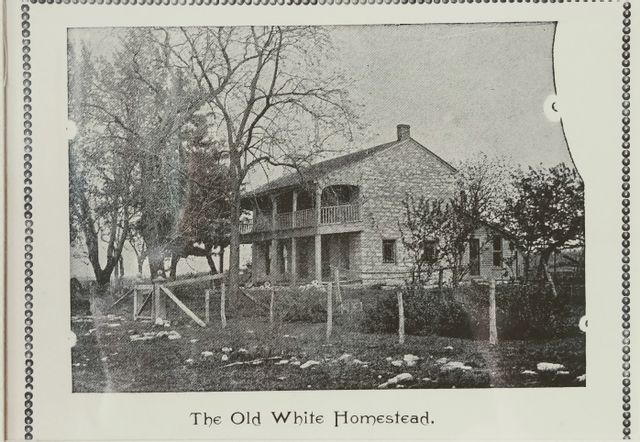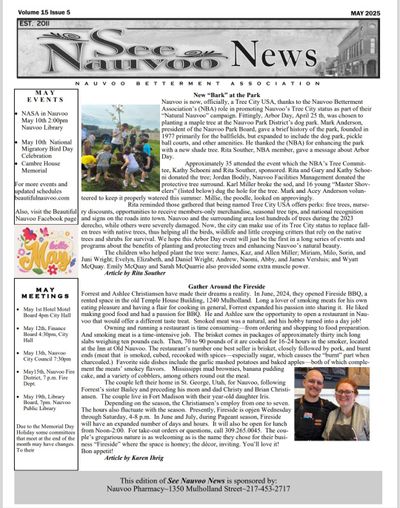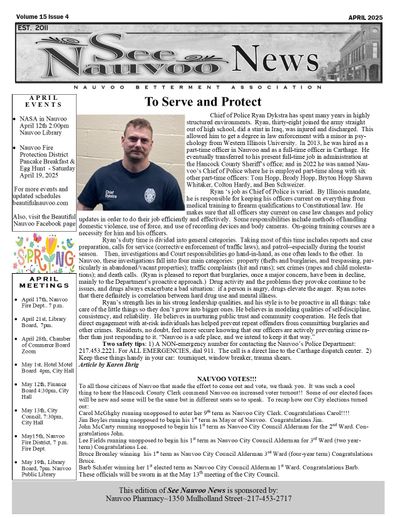EARLY MISSISSIPPI NATIVE AMERICANS AND NAUVOO
Exploration and Settlement

Among the first European explorers to see the Nauvoo Peninsula of which we have record were Father Jacques Marquette and Louis Joliet late in June 1673. On the 25th of that month, Marquette and Joliet encountered a tribe of Illinois Indians near present-day Keokuk, Iowa. For the next 125 years, the historical record is nearly silent, French and Spanish explorers and traders often made their way through the area. One Nauvoo resident found a Spanish coin dated 1622, and another found a handful in his asparagus garden dated 1803. In November of 1804, Pierre Chouteau, a newly appointed US Agent of Indian Affairs, was given the official title to the land acquired through the Treaty of 1804, and directed to establish a post to supply the Sauk and Fox "goods at a more reasonable rate than they have been accustomed to procure them." Wasting no time, Choteau chose a young man named William Ewing to erect the post and teach the Natives the science of agriculture. Accompanied by an interpreter, William Ewing set out early in the spring of 1805, and stopped at a spot opposite to the Sauk village of Chief Quashquema. The two men immediately cut down many of the large oak trees that covered the southern end of the Nauvoo Peninsula and completed a two-story blockhouse by May. In August of that year, Ewing had his first official guests. Lt. Zebulon Pike had been ordered to explore the Mississippi River, find its source, and locate positions for new military forts. Pike had none of the training or scientific instruments, nor the presidential seal of approval that the Lewis and Clark Expedition of a year earlier had, but that did not stop the young intrepid from doing his duty. On the 20th of that month, Pike's Expedition reached the Des Moines Rapids and promptly got stuck. To the rescue came Ewing, his interpreter, and 19 Sauk men to help the expedition unload their keelboat and navigate the rapids. After staying the night with Ewing, Pike spent the next day meeting with the local tribes and discussing his intentions and left before nightfall. On his return trip the next April, Pike picked up two passengers at "the establishment," and took them down river a short distance. It appears that the area was already beginning to boom, for not only did Pike find passengers, but passed several groups of trappers, which the year before he had seen nearly none. William Ewing proved to be an expensive and unpopular agent, and Lt. Pike reported that he was "utterly unfit" for the position. It is not known how long Ewing remained, but his duration was definitely short. After his recall, Ewing's cabin was opened as need dictated, with a procession of agents making their way through the post. By 1810, however, the cabin sat vacant, abandoned by all except the fur trappers on their way up and down the Mississippi. In 1808, two new posts were established in the area that also served as military forts, one at Warsaw (Fort Johnson), and one at Fort Madison (Fort Madison). Neither post lasted very long, both of them being abandoned and burned by the Army during the War of 1812. After the War of 1812, the site of Fort Johnson was reclaimed, and a new post, Fort Edward, constructed. In 1817, the explorer Stephen H. Long stopped at this location and visited with the fort's commander Jefferson Davis. Again the American Frontier pushed westward, and the need for Fort Edward dwindled. Abandoned by the Army, the property was purchased by John Jacob Astor and the American Fur Company. In the 1820's the demand for beaver pelts for men's top hats was great, and the property that was at the head of the Des Moines Rapids was again viewed as a prime location for trade. In 1824, retired US Army Captain James White purchased the former Ewing cabin and land, and established his own post for trading with both the Native tribes and the fur trappers. Unable to compete with the American Fur Company, White and his family established another business of "lightering," or removing goods from boats as they would come to the Des Moines Rapids and transporting them overland while the now lighter boat was able to navigate the shallow rapids without extreme difficulty. By 1829 the area of Hancock County had grown sufficiently that a post office was needed. In March of the next year the area was given one, with Yale graduate George Y. Cutler as the postmaster of the three home settlement of Venus. In 1832 Venus had a population of 62, and was one of the top three contenders for the new county seat. However, Venus' hopes of becoming the seat were dashed when it was decided that a new town to be called Carthage should be platted in the center of Hancock County to become the seat. Situated on the prairie, travel to and from Carthage proved dangerous. After one session of court was held, many of the attendees set out for their homes at night and became lost in the tall prairie grasses for days. When Cutler heard of this, he hired Venus resident Thomas Brewer to plow a furrow from the settlement to the county seat. Though it wandered a bit in places, Brewer's plowed road served as the main route between Carthage and Nauvoo until Hancock County was replatted with roads according to the points of the compass. Today a small portion of this road can still be traveled by going to the east end of Parley Street in Nauvoo and following it to the Old Mormon Cemetery. In 1834 George Cutler died, and one month after his death the name of the village was changed to something the now nearly 100 settlers felt better suited their plans for the future: Commerce. The United States was looking at a fantastic future, with great hopes for westward expansion, and the citizens of Commerce figured to play prominently in it. The old scattering of houses was to be done away with, and a new town platted. Streets were laid out; lots were surveyed; stores were established; the future was upward. With many of the lots in Commerce being purchased, a bigger and stronger addition called Commerce City was planned. To help maintain the peace after the Black Hawk War, the United States Army established an additional fort on the site of Chief Quashquema's old village across the river in 1834, calling it Fort Des Moines. The Fort was commanded by Lieutenant Colonel Stephen Watts Kearney, who imposed martial law upon the area to help control that section of the wild American frontier. Three Dragoon companies under the command of captains E.V. Sumner, Nathaniel Boone, and Jesse B. Browne occupied the base. The fort was abandoned and burned three years later when Kearney was ordered to relocate the force to Fort Leavenworth. In the spring of 1837, the US Government again took an interest in the area, and a young Lieutenant in the Army Corps of Engineers named Robert E. Lee was dispatched to chart and tame the Des Moines Rapids. Accompanied by Lt. Montgomery Meigs, Lee and his crew spent the next three summers attempting to cut a channel through the rapids, but due to budget cutbacks the project was cancelled in 1840. There were many plans and dreams for Commerce and Commerce City, but the great Panic of 1837 put an end to them all. Land that had been purchased at great cost was now almost valueless, with no means to pay for it. People who had taken down their log homes to fit them into the new city now had no money to reconstruct them. Those who had just come and purchased property to put new homes and businesses on found themselves in the same situation. Overnight this bustling little town of 200 was nearly abandoned, leaving only a few stubborn souls who hoped that the area would somehow turn around.






